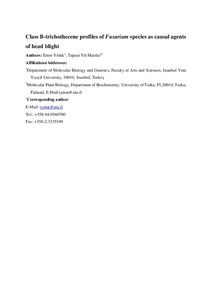Class B-Trichothecene Profiles of Fusarium Species as Causal Agents of Head Blight
Yörük Emre; Yli-Mattila Tapani
https://urn.fi/URN:NBN:fi-fe2021042821717
Tiivistelmä
Fusarium head blight is a destructive disease of all small grain cereals worldwide. More than ten Fusarium species cause the diseases; F. graminearum and F. culmorum are the major causal agents in European, Asian and American continents. The disease leads to losses in crop quality and quantity including contamination with mycotoxins in particular class B-trichothecenes. Class B-trichothecenes include deoxynivalenol (DON), nivalenol (NIV) and their acetylated derivatives (15-acetylated deoxynivalenol (15-ADON), 3-acetylated deoxynivalenol (3-ADON) and 4-acetylated nivalenol (4-ANIV). Distributions of these toxin profiles have been detected in many regions around the world. 15-ADON, F. graminearum and wheat seem to have been the major chemotype, causal agent, and host plant, respectively. Moreover, more than five host plants including barley, rice, and maize, which are economically important, have been associated with Fusarium spp. 3-ADON chemotype is predominating Northern Europe, while NIV chemotype has been reported as locally predominating profile in certain geographic regions. Current modern techniques including PCR and chromatographic analysis present reliable, fast, and informative output data worldwide. Since the toxicity of mycotoxins, aggressiveness of species, and scab resistance of host plants vary, chemotyping studies could efficiently contribute to disease management strategies.
Kokoelmat
- Rinnakkaistallenteet [27094]
